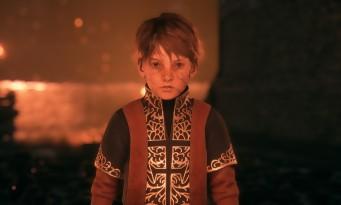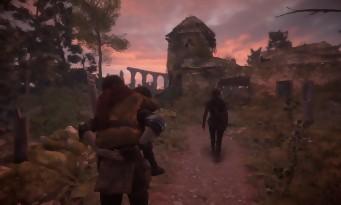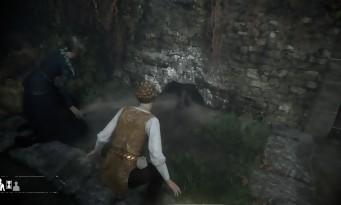 We are in the year of grace 1348, in the beautiful kingdom of France. The De Rune family lives happy days, barely disturbed by the echoes of the Hundred Years War and the strange illness from which little Hugo suffers. Okay, the picture is not exactly idyllic. But compared to what will happen, it is nothing! Between the assassination of their parents by the Inquisition and the onslaught of plague-carrying rats, Hugo and his big sister Amicia clearly ate their white bread. A Plague Tale offers a universe in the image of its artistic direction: generally realistic, with some fantastic elements here and there just to spice up the recipe. Everything works very well and is reinforced by a controlled narration, which knows how to take its time when necessary, develop the relationships between the different characters, and approach certain subjects with much less lightness than most video games. Thus, the first murders committed by Amicia and Hugo, as inevitable and justified as they are, will be rather badly experienced by the latter. Their young age and good upbringing did not prepare them for this, and the game reflects this. In a more expected, but also successful way, the fraternal bonds which unite our two heroes are largely put forward, via the dialogues and the scriptwriting events mainly, but also through a few small touching interactions. At the start of the adventure, for example, we spend a lot of time controlling Amicia even though she has to hold her little brother's hand almost constantly. Over time other kids will come to enrich the tribe, and each time the relationship between these different fellow travelers will be carefully developed. In addition, certain passages carried out in the company of these not so secondary characters are the occasion for small temporary gameplay modifications, since it is possible to give them simplistic orders (Hugo can sneak in certain passages, Melie knows how to pick locks , Rodric is able to stun isolated enemies...)
We are in the year of grace 1348, in the beautiful kingdom of France. The De Rune family lives happy days, barely disturbed by the echoes of the Hundred Years War and the strange illness from which little Hugo suffers. Okay, the picture is not exactly idyllic. But compared to what will happen, it is nothing! Between the assassination of their parents by the Inquisition and the onslaught of plague-carrying rats, Hugo and his big sister Amicia clearly ate their white bread. A Plague Tale offers a universe in the image of its artistic direction: generally realistic, with some fantastic elements here and there just to spice up the recipe. Everything works very well and is reinforced by a controlled narration, which knows how to take its time when necessary, develop the relationships between the different characters, and approach certain subjects with much less lightness than most video games. Thus, the first murders committed by Amicia and Hugo, as inevitable and justified as they are, will be rather badly experienced by the latter. Their young age and good upbringing did not prepare them for this, and the game reflects this. In a more expected, but also successful way, the fraternal bonds which unite our two heroes are largely put forward, via the dialogues and the scriptwriting events mainly, but also through a few small touching interactions. At the start of the adventure, for example, we spend a lot of time controlling Amicia even though she has to hold her little brother's hand almost constantly. Over time other kids will come to enrich the tribe, and each time the relationship between these different fellow travelers will be carefully developed. In addition, certain passages carried out in the company of these not so secondary characters are the occasion for small temporary gameplay modifications, since it is possible to give them simplistic orders (Hugo can sneak in certain passages, Melie knows how to pick locks , Rodric is able to stun isolated enemies...)
 As you probably already know, A Plague Tale gives pride of place to infiltration, which is also perfectly consistent with the profile of our young heroes. To avoid confrontation with the soldiers of the Inquisition, we can therefore squat behind covering elements, hide in tall grass, or even throw stones at metal objects or break pots to divert attention for a few moments. of an enemy. Moreover, Amicia is equipped with a sling, certainly noisy but capable of putting out of harm's way a soldier without a helmet. All of this is very classic, but the presence of veritable hordes of rats (the game can manage several thousand of them simultaneously) quickly changes the game. Visually, the organic management of these rodent clusters is very impressive. They literally swarm, devouring everything in their path, and sneaking into the slightest gap to avoid light sources. This weakness is naturally taken advantage of by Amicia and her gang who, to ward off these filthy black rats, can carry torches, ignite sticks (which burn up quickly), push mobile braziers, direct swiveling spotlights, or even use the slingshot to clinch chandeliers. On occasion, we can also drop hams to attract rodents, or break the lanterns carried by certain guards so that they quickly find themselves boneless. All this constitutes the heart of a gameplay that is a bit interventionist and mechanical at times, but which manages to go beyond the stage of a gimmick or a very good prototype thanks to constant evolution. Thus, Amicia becomes capable over time of creating Ignifer to light the embers, Somnum to put an enemy approached from behind to sleep, Devorantis to force a soldier to remove his helmet, Luminosa to destroy a group of rats, Odoris to attract rodents to a specific location (if possible near an enemy, etc.) and Exstinguis to put out fires. And we will keep silent about one last possibility available towards the end of the adventure, so as not to spoil the surprise for you. All of these abilities serve both to evade enemies and to solve a few environmental puzzles that are never too complex.
As you probably already know, A Plague Tale gives pride of place to infiltration, which is also perfectly consistent with the profile of our young heroes. To avoid confrontation with the soldiers of the Inquisition, we can therefore squat behind covering elements, hide in tall grass, or even throw stones at metal objects or break pots to divert attention for a few moments. of an enemy. Moreover, Amicia is equipped with a sling, certainly noisy but capable of putting out of harm's way a soldier without a helmet. All of this is very classic, but the presence of veritable hordes of rats (the game can manage several thousand of them simultaneously) quickly changes the game. Visually, the organic management of these rodent clusters is very impressive. They literally swarm, devouring everything in their path, and sneaking into the slightest gap to avoid light sources. This weakness is naturally taken advantage of by Amicia and her gang who, to ward off these filthy black rats, can carry torches, ignite sticks (which burn up quickly), push mobile braziers, direct swiveling spotlights, or even use the slingshot to clinch chandeliers. On occasion, we can also drop hams to attract rodents, or break the lanterns carried by certain guards so that they quickly find themselves boneless. All this constitutes the heart of a gameplay that is a bit interventionist and mechanical at times, but which manages to go beyond the stage of a gimmick or a very good prototype thanks to constant evolution. Thus, Amicia becomes capable over time of creating Ignifer to light the embers, Somnum to put an enemy approached from behind to sleep, Devorantis to force a soldier to remove his helmet, Luminosa to destroy a group of rats, Odoris to attract rodents to a specific location (if possible near an enemy, etc.) and Exstinguis to put out fires. And we will keep silent about one last possibility available towards the end of the adventure, so as not to spoil the surprise for you. All of these abilities serve both to evade enemies and to solve a few environmental puzzles that are never too complex.
AH IT'S BEAUTIFUL STUDIO
 Fans of crafts and talent trees will be happy to learn that it is possible to pick up alcohol, cloth, leather, tools, saltpeter and other strings in the scenery in order to improve equipment and skills. Amicia's abilities. There are thus about twenty improvements (quieter movements, faster aiming, greater quantity of ammunition, increased duration of the Odoris, sling capable of blowing up helmets, etc.). All these elements therefore serve as a pleasant gameplay, which can still be blamed for a minimal effort in terms of artificial intelligence. In particular, it is very easy to sow guards who have spotted us, as they tend not to pursue us far or long. But it would be a serious mistake to block on this defect (moreover common to many stealth games) because A Plague Tale has a lot of qualities to show off. Especially when it comes to the attention to detail. Thus, rather than directing the player stuck in an enigma by an artificial system of indices, the game prefers to slip an oral indication through the characters on the screen. It's much more immersive, and some players may not even realize they've been helped. We can also notice many "useless and therefore essential" animations, such as Hugo who bites into an apple that has just been given to him, Amicia who does not use a magic inventory to store a large book but attaches it to her back, characters who slow down and raise their feet excessively when they cross a muddy expanse, and lots of little animations that reinforce the link between the characters mentioned above (Amicia who carries Hugo when he feels bad, who helps the youngest to climb , who is waiting for his brother at the bottom of a ladder...).
Fans of crafts and talent trees will be happy to learn that it is possible to pick up alcohol, cloth, leather, tools, saltpeter and other strings in the scenery in order to improve equipment and skills. Amicia's abilities. There are thus about twenty improvements (quieter movements, faster aiming, greater quantity of ammunition, increased duration of the Odoris, sling capable of blowing up helmets, etc.). All these elements therefore serve as a pleasant gameplay, which can still be blamed for a minimal effort in terms of artificial intelligence. In particular, it is very easy to sow guards who have spotted us, as they tend not to pursue us far or long. But it would be a serious mistake to block on this defect (moreover common to many stealth games) because A Plague Tale has a lot of qualities to show off. Especially when it comes to the attention to detail. Thus, rather than directing the player stuck in an enigma by an artificial system of indices, the game prefers to slip an oral indication through the characters on the screen. It's much more immersive, and some players may not even realize they've been helped. We can also notice many "useless and therefore essential" animations, such as Hugo who bites into an apple that has just been given to him, Amicia who does not use a magic inventory to store a large book but attaches it to her back, characters who slow down and raise their feet excessively when they cross a muddy expanse, and lots of little animations that reinforce the link between the characters mentioned above (Amicia who carries Hugo when he feels bad, who helps the youngest to climb , who is waiting for his brother at the bottom of a ladder...).
HUGO, THIS DELIRATION
 Good (small) point also for the essential collectibles, which have the merit of giving access to nice information on the Middle Ages. And good (big) point for the fully customizable interface, which gives us the possibility of removing the elements we want from the screen. The final boss, even if it strays from the initial promise of realism and turns out to be fully "video game", is also worthy of praise, while the soundtrack is almost flawless. The music with medieval accents gives pride of place to old instruments (classical guitar, cello, nyckelharpa, viola da gamba, etc.) while the acting is very good, whether in French or in English. And you can change languages on the fly. In short, on many points A Plague Tale could show more than one AAA. Even the graphics manage to impress at times, especially during the panoramas that open each chapter. We can note here or there the presence of characters less well modeled than others or textures that take a moment too long to appear, but the only real major defect as regards the visual aspect comes from a very artistic choice. amazing: chromatic aberration. This filter, which has been in fashion for a few years (we are still trying to figure out why…), consists of making the graphics located outside the central area of the screen slightly blurry and runny. The effect is subtle, fortunately, but we notice it all the same, especially on PC (high definition and player close to the screen oblige). And above all, he is as ugly and useless as his description might suggest. It's very simple, after ten hours of play, we were still not used to it. But don't let this point of detail, as well as this relatively modest lifespan, prevent you from diving into the adventure. A Plague Tale: Innocence is one of the games with a strong personality that leaves lasting memories. At a time when tasteless clones are coming out in droves, you can't refuse!
Good (small) point also for the essential collectibles, which have the merit of giving access to nice information on the Middle Ages. And good (big) point for the fully customizable interface, which gives us the possibility of removing the elements we want from the screen. The final boss, even if it strays from the initial promise of realism and turns out to be fully "video game", is also worthy of praise, while the soundtrack is almost flawless. The music with medieval accents gives pride of place to old instruments (classical guitar, cello, nyckelharpa, viola da gamba, etc.) while the acting is very good, whether in French or in English. And you can change languages on the fly. In short, on many points A Plague Tale could show more than one AAA. Even the graphics manage to impress at times, especially during the panoramas that open each chapter. We can note here or there the presence of characters less well modeled than others or textures that take a moment too long to appear, but the only real major defect as regards the visual aspect comes from a very artistic choice. amazing: chromatic aberration. This filter, which has been in fashion for a few years (we are still trying to figure out why…), consists of making the graphics located outside the central area of the screen slightly blurry and runny. The effect is subtle, fortunately, but we notice it all the same, especially on PC (high definition and player close to the screen oblige). And above all, he is as ugly and useless as his description might suggest. It's very simple, after ten hours of play, we were still not used to it. But don't let this point of detail, as well as this relatively modest lifespan, prevent you from diving into the adventure. A Plague Tale: Innocence is one of the games with a strong personality that leaves lasting memories. At a time when tasteless clones are coming out in droves, you can't refuse!

























